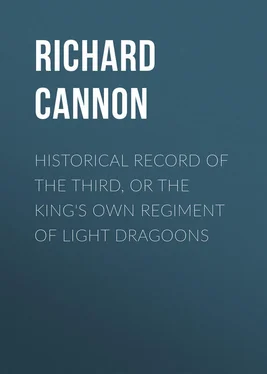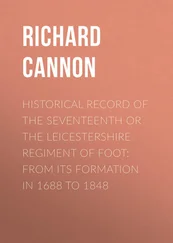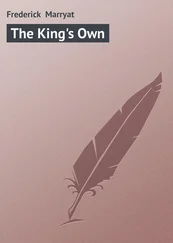Richard Cannon - Historical Record of the Third, Or the King's Own Regiment of Light Dragoons
Здесь есть возможность читать онлайн «Richard Cannon - Historical Record of the Third, Or the King's Own Regiment of Light Dragoons» — ознакомительный отрывок электронной книги совершенно бесплатно, а после прочтения отрывка купить полную версию. В некоторых случаях можно слушать аудио, скачать через торрент в формате fb2 и присутствует краткое содержание. Издательство: Иностранный паблик, Жанр: foreign_antique, foreign_prose, на английском языке. Описание произведения, (предисловие) а так же отзывы посетителей доступны на портале библиотеки ЛибКат.
- Название:Historical Record of the Third, Or the King's Own Regiment of Light Dragoons
- Автор:
- Издательство:Иностранный паблик
- Жанр:
- Год:неизвестен
- ISBN:нет данных
- Рейтинг книги:3 / 5. Голосов: 1
-
Избранное:Добавить в избранное
- Отзывы:
-
Ваша оценка:
- 60
- 1
- 2
- 3
- 4
- 5
Historical Record of the Third, Or the King's Own Regiment of Light Dragoons: краткое содержание, описание и аннотация
Предлагаем к чтению аннотацию, описание, краткое содержание или предисловие (зависит от того, что написал сам автор книги «Historical Record of the Third, Or the King's Own Regiment of Light Dragoons»). Если вы не нашли необходимую информацию о книге — напишите в комментариях, мы постараемся отыскать её.
Historical Record of the Third, Or the King's Own Regiment of Light Dragoons — читать онлайн ознакомительный отрывок
Ниже представлен текст книги, разбитый по страницам. Система сохранения места последней прочитанной страницы, позволяет с удобством читать онлайн бесплатно книгу «Historical Record of the Third, Or the King's Own Regiment of Light Dragoons», без необходимости каждый раз заново искать на чём Вы остановились. Поставьте закладку, и сможете в любой момент перейти на страницу, на которой закончили чтение.
Интервал:
Закладка:
1692
1693
With the fall of Limerick ended the war in Ireland 12 12 The account of the services of the regiment in Ireland has been taken from the Official Records – London Gazettes – Accounts published by authority in 1690, and 1691 – State of Europe – Story's History of the War in Ireland – Harris' Life of King William III. – and Boyer's Life of King William III.
; and the regiment having embarked for England, landed at Barnstaple on the 18th of March, 1692. Its establishment was six troops, 360 men, and its expense 15,999 l. 3 s. 4 d. per annum. During this and the following year it was stationed in the south and western counties of England.
1694
On the 19th of January, 1694, Brigadier-General Leveson was removed to the third horse, now second dragoon guards; and the colonelcy of the Queen's dragoons was conferred upon Thomas, Lord Fairfax, from lieut. – colonel of the second troop (now second regiment) of life guards.
At this period King William was engaged in a war with France, and the third horse and Queen's dragoons having been reviewed by His Majesty in Hyde Park, on the 26th of March embarked for foreign service. The Queen's dragoons landed at Williamstadt, in North Brabant, on the 16th of April 1694, joined the army encamped at Tirlemont on the 21st of June, and was again reviewed by His Majesty on the following day. Its excellent conduct in Ireland appears to have raised the regiment high in the King's estimation, and it was ordered to encamp beyond the defiles of the village of Roosebeck, to cover His Majesty's quarters 13 13 D'Auvergne's History of the Campaign in Flanders.
.
The regiment served the campaign of this year in brigade with the royals and royal Scots dragoons, and was employed in manœuvring and skirmishing in the valleys of Brabant and in the verdant plains of Flanders. No general engagement occurred, and in October it went into quarters at Ghent.
1695
In February, 1695, Lord Fairfax having retired, King William conferred the colonelcy on Colonel William Lloyd : at the same time the establishment was augmented to eight troops of thirty-eight officers, seventy-two non-commissioned officers, and four hundred and eighty privates, the annual expense being increased to 20,652 l. 18 s. 4 d.
Having passed the winter in barracks at Ghent and received a remount from England, the Queen's dragoons marched, in April 1695, to Dixmude in West Flanders, and encamped on the plains of the Yperlee. A small detached corps was assembled at this place under Major-General Ellemberg, and in June an attack was made on the forts at Kenoque, to draw the French troops that way, and to facilitate the siege of Namur, which was undertaken immediately afterwards.
The Queen's dragoons, with eight battalions of infantry, returned to Dixmude, and the remainder of the division marched to the main army before Namur.
While the army was besieging Namur, a French force, commanded by General de Montal, invested Dixmude (15th July), and carried on the approaches with great expedition. The governor, Major-General Ellemberg, called a council of war, and suggested the expediency of surrendering. This was opposed by Major Beaumont, who commanded the Queen's dragoons 14 14 Colonel Lloyd being sick at Brussels and the Lieutenant-Colonel on leave of absence.
, and some other officers, but it was agreed to by the majority, and the garrison was delivered up prisoners of war. Thus, the gallant dragoons, after displaying the greatest valour in former campaigns, were tamely consigned into the hands of the enemy, by a timid, or treacherous, foreign general officer. The soldiers were enraged at not being permitted to defend the place; many of the men broke their arms before they delivered them up, and one British regiment tore its colours to pieces.
An agreement had previously been made by the contending powers, that all prisoners should be given up on certain conditions. These conditions were complied with, and the return of the regiments which had surrendered, was demanded; but the French court refused to give them up. At length the citadel of Namur capitulated, and the French garrison was permitted to march out without being made prisoners, but as they passed through the allied army, their commander, Marshal Boufflers, was arrested and detained until the conditions of the agreement were complied with. The detention of the marshal produced the release of the regiments; the Queen's dragoons returned to the army, and were ordered into barracks at Ghent. At the same time a general court-martial assembled for the trial of the officers who had delivered the regiments into the power of the enemy. The governor of Dixmude, Major-General Ellemberg, was sentenced to be beheaded, and was executed at Ghent on the 20th of November. Colonels Graham, O'Farrell, Lesly, and Aver, were cashiered; two others were suspended, and the remainder acquitted. After the army left the field, the Queen's dragoons were quartered in villages near the canal of Sluys.
Конец ознакомительного фрагмента.
Текст предоставлен ООО «ЛитРес».
Прочитайте эту книгу целиком, купив полную легальную версию на ЛитРес.
Безопасно оплатить книгу можно банковской картой Visa, MasterCard, Maestro, со счета мобильного телефона, с платежного терминала, в салоне МТС или Связной, через PayPal, WebMoney, Яндекс.Деньги, QIWI Кошелек, бонусными картами или другим удобным Вам способом.
1
In the 14th year of the reign of Edward IV. a small force was established in Ireland by Parliament, consisting of 120 Archers on horseback, 40 Horsemen, and 40 Pages.
2
Military Papers, State Paper Office.
3
This Regiment was disbanded after the Peace of 1674.
4
This appears to be the first introduction of bayonets into the English Army.
5
State Paper Office.
6
The first issue of carbines to the regular Horse appears to have taken place in 1684; the Life Guards, however, carried carbines from their formation in 1660. — Vide the 'Historical Record of the Life Guards.'
7
Histoire de la Milice Françoise , par le Père Daniel.
8
National Records.
9
The equipment of Hussars at this period is described by D'Auvergne, in his History of the Campaign of 1694 , pp. 22, 23.
10
The Third, ranked as Second Dragoons; the Fourth as Third; and the Second as Fourth; until the peace of Utrecht, when the claim of the Greys to precedence was submitted to a board of general officers and admitted. — See the Historical Record of the Scots Greys.
11
Major Wood rose to the rank of lieut. – general. See a memoir of this distinguished officer in the record of the third dragoon guards.
12
The account of the services of the regiment in Ireland has been taken from the Official Records – London Gazettes – Accounts published by authority in 1690, and 1691 – State of Europe – Story's History of the War in Ireland – Harris' Life of King William III. – and Boyer's Life of King William III.
Читать дальшеИнтервал:
Закладка:
Похожие книги на «Historical Record of the Third, Or the King's Own Regiment of Light Dragoons»
Представляем Вашему вниманию похожие книги на «Historical Record of the Third, Or the King's Own Regiment of Light Dragoons» списком для выбора. Мы отобрали схожую по названию и смыслу литературу в надежде предоставить читателям больше вариантов отыскать новые, интересные, ещё непрочитанные произведения.
Обсуждение, отзывы о книге «Historical Record of the Third, Or the King's Own Regiment of Light Dragoons» и просто собственные мнения читателей. Оставьте ваши комментарии, напишите, что Вы думаете о произведении, его смысле или главных героях. Укажите что конкретно понравилось, а что нет, и почему Вы так считаете.












